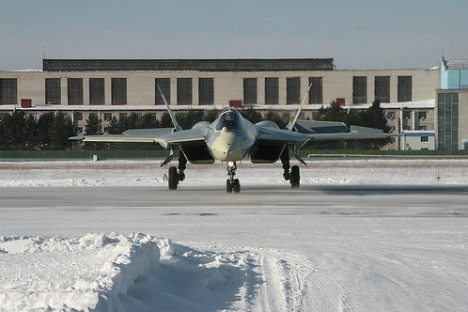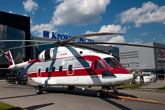Russian pilots show they can hit the target at Aviadarts

Source: Igor Filonov
Late last month, Russia’s best pilots had the opportunity toshow off their skills in the Aviadarts competition, which took place between 21-26 Mayat the Pogonovo range 600 km south of Moscow.
Attack helicopters, fighters, and ground attack aircraft hit ground targets, while military transport helicopters dropped their cargoes on the designated drop sites. Aside from participating in the competition, Mi-26 was called upon to put out a real fire.
This is the second year running that this all-army flight training competition for Air Force crews has been held. For this year’s event the list of participants was expanded considerably: Military transport and long-range aviation took part in the competition for the first time, including the Tu-22M3.
This strategic cruise missile carrying aircraft is capable of carrying three X-22 cruise missiles (each of these is able to sink an aircraft carrier), and is also able to drop 24 tons of bombs on an enemy.
Source: Igor Filonov
For this competition, however, the aircraft were each loaded with a 250 kg unguided bomb. Crews had to hit a target the size of a lorry with this bomb from an altitude of 600 m and at an appropriate speed – a test of accuracy that can be compared to throwing a coin into the coin slot on a petrol pump from a moving car. The pilots hit the target.
For prestige and glory
“This all in a day’s work and beautiful weather made the mission easier; even so this is by no means an easy task,” explained Nikolai Ageyev, the commander of the winning crew, based at Shaykovka airbase near Kaluga.“Crews had to takeoff and head for the target at the appointed time, drop the bomb on the target and depart on time.
“We were successful thanks to our training and experience,” he added, describing the honor of participating in Aviadartsas “glorious, prestigious.”
“We wanted to prove that we are the best,” he said. Ageyev’s crew won two qualifying rounds to get through to the final.
“My father was a navigator in this regiment but he has now retired. He is worried about me back in Barnaul, I am going to call him now and tell him that we won,”said Alexander Sapovatov, the cruise missile carrier’s navigation systems operator.
A total of 71 crews from all of Russia’s military districts participated in the competition. Aircraft and helicopters flew in from three airbases: Voronezh, Lipetsk, and Ryazan. As they approached the range they would have penetrated air defenses, represented by the Plantsir-S1air-defense missile system.
Considering the capabilities of this system, an encounter of this nature could have ended in a real-life battle. During Aviadarts, however, the battle was played out over the airwaves, on the invisible frequencies of radio-electronic warfare. Incidentally as the aircraft and helicopters drew level with the control tower at the command post, mobile communications deteriorated considerably.
Defence Minister Sergei Shoigu, who flew in to view the training exercise, watched aerobatic displays as well as bombing and strafing exercises. General Kharchevsky, head of the Lipetsk FlightTest Center, who once gave Putin a ride in a fighter jet, performed an aerial ballet in a Su-30SM, the world’s first super-manoeuvrable combat aircraft.
Related:
Packing a punch while protecting the infantry
The grey fighter with its pointed nose stood at first on its tail, motionless, and then entered a spin, like a dead sycamore leaf. A pair of fifth generation T-50 aircraft, broad and flat just like a Ferrari, flew across the range.
A Kamov Ka-52 ‘Alligator’ performed aerobatics that were no less impressive than the fighters. The plane’s coaxial rotors allow it to fly backwards and sideways as well as being able to encircle an enemy, firing on them continuously whilst not giving them a chance to return fire. After completing its display the Ka-52 bowed to spectators and returned to base.
To be at war is to be at war
In a scene reminiscent of medicine being dispensed in a hospital, weapons technicians make their way along the line of attack helicopters on the hard standings at the Baltimor airbase. They are loading the ‘Krokodily’ (Crocodiles), ‘Alligatory’ (Alligators), and ‘Nochnye Okhotniki’ (Night Hunters) with strictly controlled parcels of ammunition.
“Where are their projectiles?” grumbles a technician, moving the green boxes inside the body of a truck. “Where is their representative?”
“In Komsomolsk-on-Amur,” comes the reply from the ground, naming a city in the Russian Far East.
As the crews are to compete on the basis of their accuracy, they are allocated the minimum ammunition: two rockets and 10 projectiles. A short feed belt is inserted into the belly of a helicopter and the catch on the gun is pulled back using a meter-long spring.
The helicopters depart in pairs for the target, and the rockets spread out across the sky, rustling like a snake. The sound of tearing fabric rings out - the helicopters are using their guns. The targets vanish in a cloud of smoke and dust. Meanwhile, judges observe the hits with the help of drones and cameras placed close to the targets.
Real-life emergency
After the ground attack aircraft had completed their attacks on ground targets, the grass caught fire at Pogonovo. The heat and wind fanned the flames across the endless fields that form the range.
An Mi-26, the world’s largest military-transport helicopter from Torzhok airbase in the Tver Region, attached itself to a tub on the end of a long cable and set off to extinguish the fire.
The helicopter scooped three tons of water each time from a lake not far from the command post and poured it onto the black, smoking patches of ground. Two trips were all that was necessary to put out the fire.
Aviadarts is an excellent demonstration of the flying skills of Russian pilots and that they are able to hit targets on their first approach. It also demonstrates that the money that taxpayers give to the Army is not spent in vain,” explained Commander in Chief of the Russian Air Force Viktor Bondaryov.
Bondaryov awarded medals to the victors. In addition, the pilots who won first prize gained the right to non-competitive entry to the Academy and to go through to the international phase of Aviadarts, which takes place at Pogonovo at the end of July. Pilots will fly in for this competition from Belarus, Kazakhstan, and China, and the winners will drive away in their new cars.
Read more: Versatility is the watchword for new light helicopter>>>
All rights reserved by Rossiyskaya Gazeta.
Subscribe
to our newsletter!
Get the week's best stories straight to your inbox

